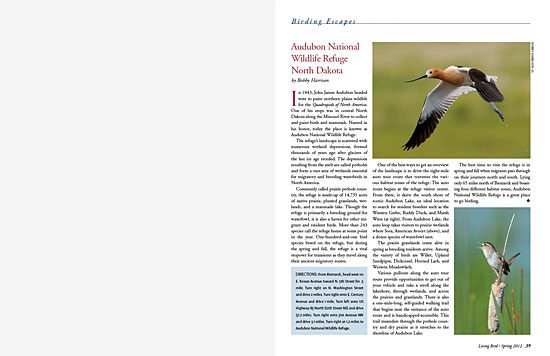Birding Escapes: Audubon National Wildlife Refuge North Dakota
Text and photographs by Bobby Harrison
April 15, 2012

In 1843, John James Audubon headed west to paint northern plains wildlife for the Quadrupeds of North America. One of his stops was in central North Dakota along the Missouri River to collect and paint birds and mammals. Named in his honor, today the place is known as Audubon National Wildlife Refuge.
The refuge’s landscape is scattered with numerous wetland depressions, formed thousands of years ago after glaciers of the last ice age receded. The depressions resulting from the melt are called potholes and form a vast area of wetlands essential for migratory and breeding waterbirds in North America.
Commonly called prairie pothole country, the refuge is made-up of 14,735 acres of native prairie, planted grasslands, wetlands, and a manmade lake. Though the refuge is primarily a breeding ground for waterfowl, it is also a haven for other migrant and resident birds. More than 243 species call the refuge home at some point in the year. One-hundred-and-one bird species breed on the refuge, but during the spring and fall, the refuge is a vital stopover for transients as they travel along their ancient migratory routes.
One of the best ways to get an overview of the landscape is to drive the eight-mile auto tour route that traverses the various habitat zones of the refuge. The auto route begins at the refuge visitor center. From there, it skirts the south shore of scenic Audubon Lake, an ideal location to search for resident breeders such as the Western Grebe, Ruddy Duck, and Marsh Wren. From Audubon Lake, the auto loop takes visitors to prairie wetlands where Sora, American Avocet, and a dozen species of waterfowl nest.
The prairie grasslands come alive in spring as breeding residents arrive. Among the variety of birds are Willet, Upland Sandpiper, Dickcissel, Horned Lark, and Western Meadowlark.
Various pullouts along the auto tour route provide opportunities to get out of your vehicle and take a stroll along the lakeshore, through wetlands, and across the prairies and grasslands. There is also a one-mile-long, self-guided walking trail that begins near the entrance of the auto route and is handicapped-accessible. This trail meanders through the pothole country and dry prairie as it stretches to the shoreline of Audubon Lake.
The best time to visit the refuge is in spring and fall when migrants pass through on their journeys north and south. Lying only 65 miles north of Bismarck and boasting four different habitat zones, Audubon National Wildlife Refuge is a great place to go birding.


All About Birds is a free resource
Available for everyone,
funded by donors like you





